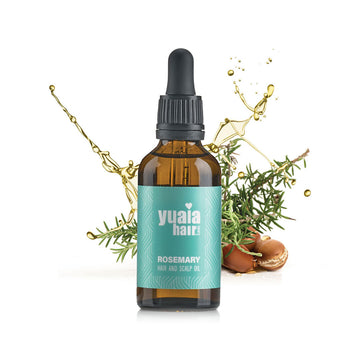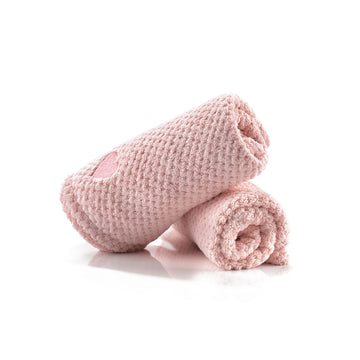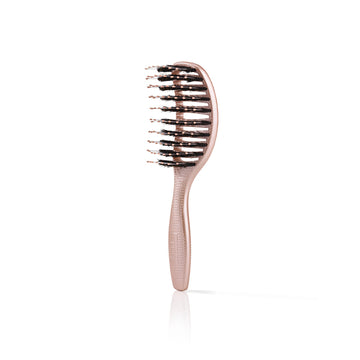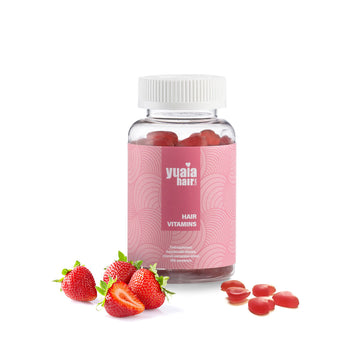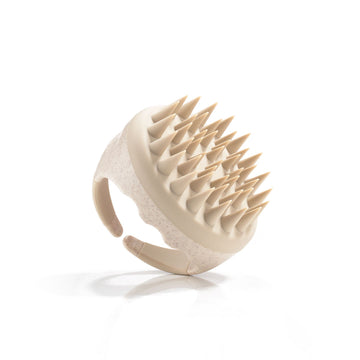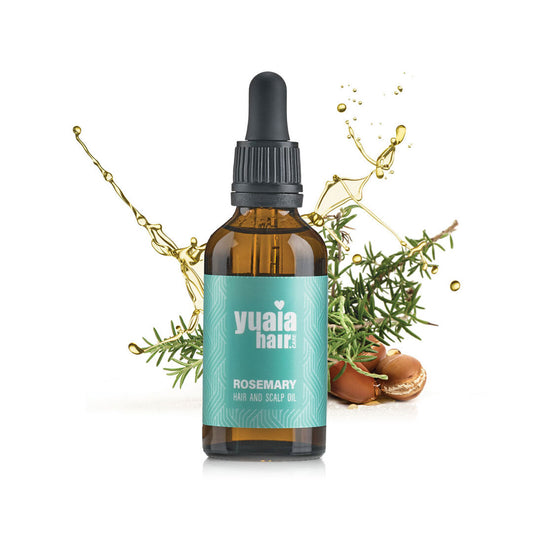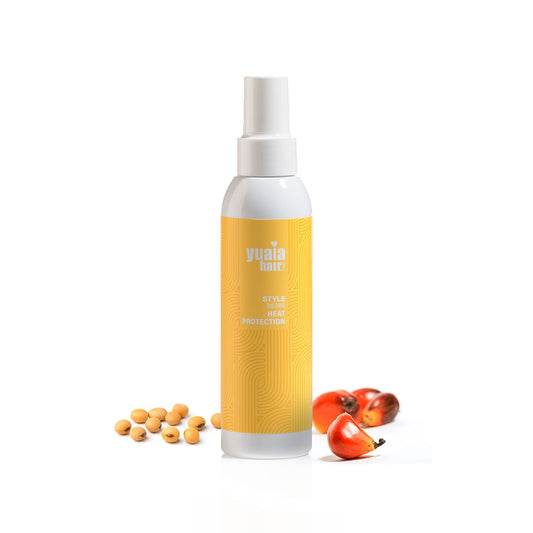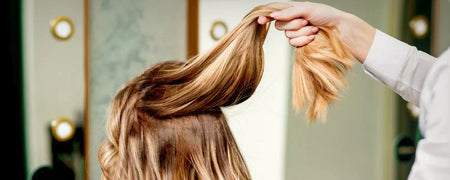
Scalp size
Influence of the size of the scalp on the amount of hair: The size of the scalp can have an effect on the number of hairs on the head. A larger scalp can accommodate more hair follicles, resulting in an increased amount of hair.
Ideal hair density based on scalp area: To calculate the ideal hair density based on scalp area, it is important to consider individual differences. Generally speaking, an area with 200-300 hair follicles per square centimeters as being normal for adults.
Variation in hair volume based on individual differences in scalp size: Individual differences in human scalp sizes contribute to the variation in the number of natural and healthy strands of hair. People with smaller scalps may have fewer strands overall, while those with larger scalps often have more hair follicles, leading to greater hair density.
What is hair density?
Hair density refers to the number of individual hair strands per square inch (or centimeter) of the scalp. It indicates how closely packed your hair strands are and determines whether your hair appears thick or sparse.
Hair density is often confused with hair thickness, but they are two distinct concepts:
- Hair density measures the total number of hair follicles in a specific area of the scalp.
- Hair thickness refers to the diameter or width of each individual hair strand.
The average person has approximately 80,000 to 120,000 hair follicles on their scalp, but this number can vary depending on genetics, age, and other factors.
Understanding your hair density can help you choose the right products, hairstyles, and care routines to best support your hair’s appearance and health.
What types of hair density are there?
Hair density is typically categorized into three main types: low, medium, and high. These categories are determined by the number of hair strands per square centimeter of the scalp and can influence how your hair looks and feels.
- Low hair density: This type refers to fewer hair strands on the scalp, making the hair appear sparse or thin. The scalp may be easily visible, especially when the hair is parted.
- Medium hair density: This is the most common type, where the scalp is partially visible when hair is parted. The hair appears neither too thin nor overly thick, offering a balanced look.
- High hair density: Hair with high density has a large number of strands closely packed together, giving the hair a full and voluminous appearance. The scalp is rarely visible, even when the hair is parted.
Understanding your hair density can help you choose suitable hairstyles, products, and care routines that work best for your hair type.
How do I know what my hair density is?
To assess your hair density, you can use simple methods like visual inspection, the ponytail circumference test, or seek a professional assessment.
Visual inspection is the easiest method. Check your scalp in natural light: if it’s easily visible, your hair density is likely low. If it’s partially visible, it’s considered medium. If the scalp is barely visible, you likely have high hair density.
Another method is the ponytail circumference test. Gather your dry hair into a low ponytail and measure the circumference:
- Less than 5 cm indicates low density
- Between 5–10 cm suggests medium density
- More than 10 cm points to high density
For the most accurate results, a professional assessment from a dermatologist or trichologist is ideal. They may use tools like a phototrichogram to measure density or a trichoscope to examine the scalp and follicles closely.
What can affect hair density?
Hair density is influenced by various factors, with genetics being the most significant determinant. Your DNA establishes the number of hair follicles you naturally have, which directly impacts your hair density.
The aging process also plays a role, as hair follicles may shrink or stop producing hair over time, leading to a noticeable reduction in density. Hormonal changes, such as those occurring during pregnancy, menopause, or due to thyroid imbalances, can disrupt hair growth cycles and contribute to thinning hair.
Health conditions like nutritional deficiencies, particularly a lack of iron, zinc, or vitamins such as biotin and vitamin D, can weaken hair follicles and decrease density. Addressing these deficiencies through diet or supplements is often essential for maintaining healthy hair.
Lifestyle factors, including stress, an unbalanced diet, and inadequate hair care habits, can also affect hair density. Prolonged stress can disrupt hair growth cycles, while poor diet and harsh hair treatments may weaken hair and lead to thinning over time.
How does hair grow?
It is natural to have between 100,000 and 150,000 hairs on your head. Hair grows in different phases, including a growth phase, resting phase and replacement phase. Over the course of a lifetime, we can experience loss of up to 100 hairs per day, but this is considered to be within the normal range.

Hair Growth Cycle
The anagen phase is the growth phase where the hair grows actively. This phase usually lasts for 2-6 years and about 85% of the hair on the head is in this phase at any one time. The catagen phase is the transitional phase between growth and rest. During this short period of approximately 1-2 weeks, the hair stops growing and begins to detach from the root. The telogen phase is the resting phase where the hair no longer grows or renews itself. During this period, approx. 10-15% of the hair on the head, and it can take up to three months for a new hair to start growing again after the end of the telogen phase.
Loss of hair
Hereditary hair loss can be one of the reasons why we lose hair. This is due to genes that can be passed on from previous generations. Alopecia areata is another factor that can cause hair loss. This condition is known to cause sudden patches or areas of baldness on the head. The effects of certain medications or treatments can also result in hair loss and must be considered.
Why do we lose hair?
There are several factors that can affect hair loss. Age is one of the most common causes of hair loss, as the number of hair strands naturally decreases over time. Genetics also play a role, as some people simply tend to have thinner or less hair. Hormonal changes can also contribute to hair loss, especially in women during pregnancy or menopause.
How many hairs do you normally have on your head? It varies from person to person, but on average an adult has around 100,000 to 150,000 hairs on their head. However, the number depends both on genetic factors and individual variation in the growth cycle of each follicle.

Age
Hair loss at a young age can be a concern for many, but it is actually quite normal. Many people experience hair loss or changes in hair thickness and quantity with age. But does this mean that hair volume has anything to do with age? Here are some key points to consider:
- Hair loss can occur early in life due to genetics or hormonal changes
- Hair thickness and amount can vary from person to person regardless of age
- Age plays a role in some types of hair loss, such as androgenetic alopecia
Therefore, there is no fixed answer to how much hair you normally have on your head, as it varies from individual to individual and can change over time. The best advice is always to consult a professional for additional information about your specific scenario.
Genetics
Heredity and Hair Volume - Genes can play a role in determining the number of hairs on one's head.
Can genes affect the number of hairs? - Yes, research suggests that certain genes can influence hair density in humans.
Are there differences in hair density between people based on genetics? - Yes, there are observed variations in hair density among individuals based on their genetic inheritance.
Hormonal changes
Menopause can have an impact on the amount of hair in women. Hormonal changes during this period can cause increased hair loss. These hormones can affect the amount of hair, and it is not uncommon to experience hair loss during menopause.
Find out more about causes of hair loss here.
How thick is the hair on our head?
The thickness of the hair on our head varies from person to person and it depends on various factors such as genetics, age and state of health. Generally speaking, the thickness of the hair can vary between 0.02 and 0.04 millimeters in diameter.
Human hair is made up of keratin, which is a protein produced in the hair follicles of the scalp. The keratin forms a hair fiber that grows out of the hair follicle and protrudes above the scalp.
The thickness of the hair can also be affected by various factors. For example, age can play a role, as hair tends to thin with age. Genetics also play an important role, as hair thickness often follows family patterns.
It is worth noting that the thickness of the hair can vary between different areas of the head. For example, hair is often thinner at the forehead and temples compared to the back and top of the head.
Can you increase hair density?
Hair density is primarily determined by genetics, which dictates the number of hair follicles on your scalp. This number is set at birth, so it’s not possible to increase the actual number of follicles or change your natural hair density. However, while you can’t alter your genetic makeup, you can improve the health and strength of your existing hair, giving it a fuller and healthier appearance.
By focusing on proper scalp care, nutrition, and gentle haircare routines, you can create the best conditions for healthy hair growth. Practices such as scalp massages, nutrient-rich diets, and the use of products containing biotin or keratin can help maintain normal hair and improve its overall look and feel.
Although you can’t change the number of hair follicles, taking care of your hair and scalp can make your hair appear thicker and more voluminous, supporting its natural beauty.
How to increase hair density
Although you cannot change the number of hair follicles you are born with, you can take steps to improve the health and appearance of your hair. Proper care and nourishment play a key role in achieving a fuller and healthier look.
Focus on maintaining a balanced diet rich in essential nutrients like proteins, biotin, and vitamins, which support normal hair health. Prioritizing scalp care, such as regular cleansing and gentle scalp massages, can also create a better environment for hair growth. Additionally, using haircare products with ingredients like keratin and peptides can strengthen and improve the overall look of your hair.
Nutrient-rich diet
A balanced diet plays an essential role in supporting healthy hair growth and maintaining normal hair. Proteins, biotin, vitamins, and minerals are key nutrients that strengthen hair strands and promote their overall health. Foods like eggs, nuts, fish, and leafy greens provide these important nutrients.
In addition to a nutritious diet, our hair vitamins help maintain normal hair when incorporated into your daily routine. By ensuring your hair receives the necessary nutrients, you are creating a solid foundation for healthier, fuller-looking hair.
Proper scalp care
A clean and healthy scalp is important for maintaining the best conditions for hair growth. By focusing on proper scalp care, you can support your hair’s overall health and help it appear fuller.
Regularly cleansing your scalp removes excess oil, dirt, and product buildup, which can clog hair follicles and interfere with growth. It’s important to use gentle shampoos that keep the scalp clean without stripping away natural oils.
Scalp massages are another effective way to care for your scalp. Massaging the scalp improves blood circulation, which nourishes the hair follicles and encourages stronger, healthier hair growth. Incorporating scalp massages into your routine can make a significant difference in promoting healthier-looking hair over time.
Use of good haircare products
Selecting high-quality haircare products is important for maintaining healthy hair and supporting its natural density. Ingredients such as biotin, keratin, and peptides are particularly beneficial.
- Biotin: This B vitamin helps maintain normal hair by supporting keratin production, which strengthens and protects hair strands.
- Keratin: As a structural protein, keratin improves hair strength and elasticity, reducing breakage and enhancing overall hair health.
- Peptides: These short chains of amino acids can improve hair texture and create a healthier scalp environment, supporting optimal conditions for hair growth.
Incorporating products with these ingredients into your routine can help maintain normal hair and improve its appearance. For instance, our hair vitamins are designed to help maintain normal hair when used as part of your daily regimen.
Consistency with quality haircare products, along with proper scalp care and a nutrient-rich diet, can support healthier, fuller-looking hair over time.
Natural remedies
Incorporating natural remedies into your hair care routine can help support scalp health and promote hair growth. Ingredients like rosemary oil and ginseng have been traditionally used for their beneficial properties and can improve the overall look and feel of your hair.
- Rosemary oil: Known for its ability to stimulate blood circulation in the scalp, rosemary oil can strengthen hair follicles and encourage growth. Regular use, either as part of a scalp massage or mixed with carrier oils, may lead to thicker, healthier-looking hair.
- Ginseng: This herb is believed to promote hair growth by improving blood flow to the scalp and delivering essential nutrients to the follicles. Ginseng-infused treatments can help enhance hair density and overall scalp health.
- Aloe vera: Valued for its soothing and moisturizing properties, aloe vera can reduce scalp irritation and create a healthier environment for hair growth. It’s gentle and suitable for most hair types.
- Coconut oil: Rich in fatty acids, coconut oil deeply nourishes the hair, strengthens strands, and restores moisture. It works particularly well as a conditioning treatment to protect and hydrate the hair.
Using these natural ingredients in oils and masks, combined with regular scalp massages, can help stimulate the scalp and create optimal conditions for fuller, healthier hair.
Stress management and adequate sleep
Chronic stress and lack of sleep can have a negative effect on hair health, often leading to hair thinning or hair loss. Stress disrupts the hair growth cycle, causing more strands to enter the shedding phase prematurely. Managing stress through techniques such as meditation, yoga, or deep-breathing exercises can help reduce its impact on your body and scalp.
Equally important is ensuring you get 7-9 hours of quality sleep each night. Sleep is when your body repairs and regenerates, creating the ideal conditions for healthy hair growth. Prioritizing rest and stress management can significantly improve your overall hair health.
Healthy haircare practices
Adopting gentle haircare practices is important for maintaining hair health and supporting its natural density. These habits help protect the integrity of your hair while keeping it strong and full-looking over time.
Gentle cleansing is key to maintaining a healthy scalp without stripping away natural oils. Use mild, sulfate-free shampoos that cleanse effectively while keeping the scalp balanced and nourished. Over-washing can cause dryness, so aim to wash only as needed.
Avoiding heat damage is another essential step. Excessive use of heat styling tools can weaken hair strands and lead to breakage. Minimize heat styling when possible, and always apply a heat protectant spray to shield your hair when using blow dryers, straighteners, or curling irons.
Using volumizing products like lightweight shampoos, conditioners, and sprays can add body and lift without weighing your hair down. These products help create the illusion of fuller hair while maintaining its natural movement.
By following these healthy haircare practices, you can preserve the strength and appearance of your hair, helping it look fuller and healthier.
How to care for low density hair
Caring for low-density hair involves specific strategies to enhance volume and maintain hair health. Here are some tips to help you manage and style your hair effectively:
- Use lightweight products: Opt for volumizing shampoos and conditioners that won't weigh your hair down. Lightweight styling products, such as mousses or gels, can provide hold without adding heaviness.
- Avoid heavy conditioners: Heavy conditioners can make low-density hair appear flat. Instead, use lighter formulations and apply conditioner primarily to the ends of your hair to prevent scalp buildup.
- Incorporate protein treatments: Regular protein treatments can strengthen fine hair strands, reducing breakage and improving overall hair health. Look for treatments specifically formulated for fine or low-density hair.
- Regular scalp massages: Gently massaging your scalp can stimulate blood circulation, promoting a healthier scalp environment conducive to hair growth. Incorporate this practice into your routine to support hair health.
- Limit heat styling: Excessive heat can damage fine hair, leading to breakage. When using heat styling tools, apply a heat protectant spray and opt for the lowest effective temperature settings.
By implementing these practices, you can enhance the appearance of your low-density hair, making it look fuller and healthier.
How to care for medium density hair
Medium-density hair offers versatility in styling and typically requires balanced maintenance to keep it healthy and vibrant. Here are some tips to help you care for your medium-density hair:
- Balanced cleansing routine: Use a gentle, sulfate-free shampoo to cleanse your hair without stripping its natural oils. Shampooing two to three times a week is generally sufficient to maintain cleanliness without over-drying.
- Regular conditioning: Apply a lightweight conditioner after each wash to maintain moisture balance. Focus on the mid-lengths and ends to prevent scalp buildup and keep your hair smooth and manageable.
- Deep conditioning treatments: Incorporate deep conditioning or hair masks into your routine once a week or every two weeks to provide extra hydration and nourishment, ensuring your hair remains healthy and resilient.
- Heat styling precautions: Limit the use of heat styling tools to prevent damage. When using them, always apply a heat protectant spray and opt for the lowest effective temperature settings to minimize potential harm.
- Regular trims: Schedule trims every 6-8 weeks to remove split ends and maintain the overall health and appearance of your hair.
- Scalp care: Maintain a healthy scalp by gently massaging during shampooing to stimulate blood circulation, promoting optimal hair growth and health.
By following these practices, you can maintain the health and beauty of your medium-density hair, allowing you to enjoy its natural versatility and shine.
How to care for high density hair
High-density hair, characterized by a large number of strands per square inch of scalp, often appears full and voluminous. Proper care is essential to maintain its health and manageability. Here are some tips to help you care for your high-density hair:
- Deep conditioning: Regular deep conditioning treatments provide essential moisture, keeping your hair hydrated and reducing frizz. Aim to deep condition your hair weekly to maintain its softness and manageability.
- Detangling: Gently detangle your hair using a wide-tooth comb or your fingers, preferably when it's damp and conditioned. Working in small sections can prevent breakage and make the process more manageable.
- Protective styling: Incorporate protective styles like braids, twists, or buns to manage volume and reduce daily manipulation, which can lead to breakage. These styles also help in retaining moisture.
- Regular trims: Schedule trims every 8-12 weeks to remove split ends and maintain the overall health of your hair. Regular trims prevent split ends from traveling up the hair shaft, reducing the risk of breakage.
- Scalp care: Maintain a healthy scalp by cleansing regularly to remove buildup. Consider using clarifying shampoos occasionally to ensure your scalp remains clean, promoting optimal hair growth.
By following these practices, you can maintain the health and beauty of your high-density hair, ensuring it remains vibrant and manageable.
Styling tips for different hair densities
Choosing hairstyles and techniques that suit your hair density can enhance its appearance and make it easier to manage.
Low-density hair
For low-density hair, the main goal is to create the illusion of fullness and volume. Choosing the right haircut and styling techniques can make a significant difference. Blunt cuts, such as bobs, are ideal because they create a solid edge, making the hair appear thicker. Short, soft layers can add dimension without taking away too much weight, helping the hair look naturally fuller.
Styling with curls or waves is another great way to enhance body and movement. Loose curls or soft waves add texture, making the hair look more voluminous. When blow-drying, use a round brush to lift the roots for added height. Incorporating volumizing products like lightweight mousses or root-lifting sprays can provide extra lift without weighing the hair down.
Additionally, avoiding heavy conditioners or oils near the scalp helps prevent hair from appearing flat. With the right cuts, styling techniques, and products, low-density hair can look fuller, thicker, and more vibrant.
Medium-density hair
Medium-density hair offers great versatility when it comes to styling. It has enough volume to hold various hairstyles without appearing too thin or overly bulky. Layered cuts are an excellent option for adding shape and dimension while maintaining the natural thickness of the hair. These cuts can bring movement and texture without removing too much weight.
Shoulder-length hairstyles are particularly flattering for medium-density hair. They strike a balance between length and volume, making the hair look full and healthy. Light waves or soft curls can further enhance texture and give the hair a natural, effortless appearance.
To maintain bounce and volume, choose lightweight styling products such as volumizing sprays, mousses, or creams. These products provide lift and hold without weighing the hair down.
Medium-density hair’s adaptability means you can experiment with different styles and techniques while keeping the hair’s natural balance, movement, and fullness intact.
High-density hair
High-density hair has a naturally full and voluminous appearance, but it can sometimes feel heavy or difficult to manage. Layered or thinned cuts are excellent for reducing bulk while maintaining the hair’s natural volume. Long layers, in particular, help shape the hair, allowing it to fall more evenly and preventing it from looking too dense. Thinning techniques, such as point cutting, can further refine the hair’s texture without sacrificing its fullness.
To control frizz and enhance the hair’s natural texture, smoothing products like serums, creams, or lightweight oils can be applied to the mid-lengths and ends. These products add shine and definition, making high-density hair easier to style.
When blow-drying or styling, consider using tools and techniques that provide control, such as wide-toothed combs or brushes that distribute volume evenly. By choosing the right haircut, techniques, and products, high-density hair can be kept manageable, healthy, and beautifully shaped.
Embracing your hair's natural potential
Maintaining healthy hair density starts with consistent care and nourishment. Focus on a nutrient-rich diet that supports hair health, along with proper scalp care to create the best conditions for growth. Gentle haircare practices, such as avoiding heat damage and using lightweight, nourishing products, help protect your hair’s strength and appearance.
Managing stress and ensuring adequate sleep are also key to preventing hair thinning. Natural remedies like scalp massages with rosemary oil or ginseng treatments can further support healthy hair. By combining these habits, you can enhance your hair’s overall health, allowing it to look fuller, stronger, and naturally beautiful.
 2-5 day delivery
2-5 day delivery
 25.000+ satisfied customers
25.000+ satisfied customers
 Satisfaction Guarantee
Satisfaction Guarantee










